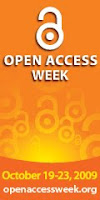Jonathan D. Smith,Professor of Molecular Medicine,Cleveland Clinic Lerner College of Medicine, Case Western Reserve University, will speak here today on: “Reverse cholesterol transport: Making ‘good’ cholesterol better.” Craig Auditorium, 12:15 p.m.
Following is a list of Dr. Smith's cholesterol-related publications, taken from Medline (via EbscoHost), exported to Refworks.com and formatted according to the Council of Science Editors style. It is a fast, easy way to create a list of references and keep track of all of the papers used for a research project. You can also share your Refworks folders with others, and link from Refworks to the full-text, if the reference was exported to Refworks from a database with OLinks. Refworks is available to everyone in the Oberlin College community. Click on
Login, once you are at the Refworks site, to sign up for an individual account.
Brown ML, Yui K, Smith JD, LeBoeuf RC, Weng W, Umeda PK, Li R, Song R, Gianturco SH, Bradley WA. 2002. The murine macrophage apoB-48 receptor gene (apob-48r): Homology to the human receptor. J Lipid Res 43(8):1181-91.
Brubaker G, Peng D, Somerlot B, Abdollahian DJ, Smith JD. 2006. Apolipoprotein A-I lysine modification: Effects on helical content, lipid binding and cholesterol acceptor activity. Biochim Biophys Acta 1761(1):64-72.
Dansky HM, Shu P, Donavan M, Montagno J, Nagle DL, Smutko JS, Roy N, Whiteing S, Barrios J, McBride TJ, et al. 2002. A phenotype-sensitizing apoe-deficient genetic background reveals novel atherosclerosis predisposition loci in the mouse. Genetics 160(4):1599-608.
Le Goff W, Settle M, Greene DJ, Morton RE, Smith JD. 2006. Reevaluation of the role of the multidrug-resistant P-glycoprotein in cellular cholesterol homeostasis. J Lipid Res 47(1):51-8.
Le Goff W, Peng D, Settle M, Brubaker G, Morton RE, Smith JD. 2004. Cyclosporin A traps ABCA1 at the plasma membrane and inhibits ABCA1-mediated lipid efflux to apolipoprotein A-I. Arterioscler Thromb Vasc Biol 24(11):2155-61.
Peng D, Brubaker G, Wu Z, Zheng L, Willard B, Kinter M, Hazen SL, Smith JD. 2008. Apolipoprotein A-I tryptophan substitution leads to resistance to myeloperoxidase-mediated loss of function. Arterioscler Thromb Vasc Biol 28(11):2063-70.
Peng D, Wu Z, Brubaker G, Zheng L, Settle M, Gross E, Kinter M, Hazen SL, Smith JD. 2005. Tyrosine modification is not required for myeloperoxidase-induced loss of apolipoprotein A-I functional activities. J Biol Chem 280(40):33775-84.
Robertson JO, Li W, Silverstein RL, Topol EJ, Smith JD. 2009. Deficiency of LRP8 in mice is associated with altered platelet function and prolonged time for in vivo thrombosis. Thromb Res 123(4):644-52.
Smith JD and Topol EJ. 2006. Identification of atherosclerosis-modifying genes: Pathogenic insights and therapeutic potential. Expert Rev Cardiovasc Ther 4(5):703-9.
Smith JD, Waelde C, Horwitz A, Zheng P. 2002. Evaluation of the role of phosphatidylserine translocase activity in ABCA1-mediated lipid efflux. J Biol Chem 277(20):17797-803.
Smith JD, Bhasin JM, Baglione J, Settle M, Xu Y, Barnard J. 2006. Atherosclerosis susceptibility loci identified from a strain intercross of apolipoprotein E-deficient mice via a high-density genome scan. Arterioscler Thromb Vasc Biol 26(3):597-603.
Smith JD, Le Goff W, Settle M, Brubaker G, Waelde C, Horwitz A, Oda MN. 2004. ABCA1 mediates concurrent cholesterol and phospholipid efflux to apolipoprotein A-I. J Lipid Res 45(4):635-44.
Velez-Carrasco W, Merkel M, Twiss CO, Smith JD. 2008. Dietary methionine effects on plasma homocysteine and HDL metabolism in mice. J Nutr Biochem 19(6):362-70.
Wu Z, Wagner MA, Zheng L, Parks JS, Shy,Jacinto M.,,3rd, Smith JD, Gogonea V, Hazen SL. 2007. The refined structure of nascent HDL reveals a key functional domain for particle maturation and dysfunction. Nat Struct Mol Biol 14(9):861-8.
Zheng L, Settle M, Brubaker G, Schmitt D, Hazen SL, Smith JD, Kinter M. 2005. Localization of nitration and chlorination sites on apolipoprotein A-I catalyzed by myeloperoxidase in human atheroma and associated oxidative impairment in ABCA1-dependent cholesterol efflux from macrophages. J Biol Chem 280(1):38-47.
Zheng L, Nukuna B, Brennan M, Sun M, Goormastic M, Settle M, Schmitt D, Fu X, Thomson L, Fox PL, et al. 2004. Apolipoprotein A-I is a selective target for myeloperoxidase-catalyzed oxidation and functional impairment in subjects with cardiovascular disease. J Clin Invest 114(4):529-41.












